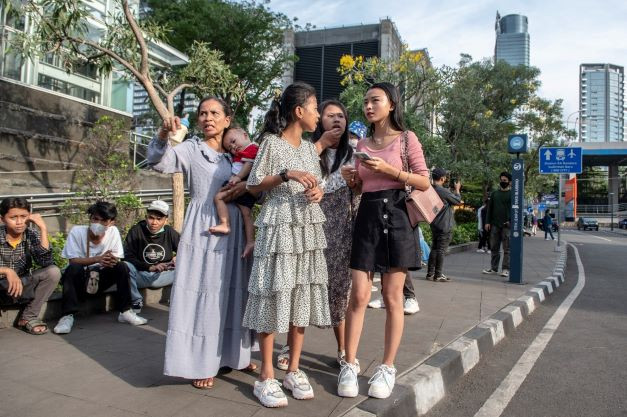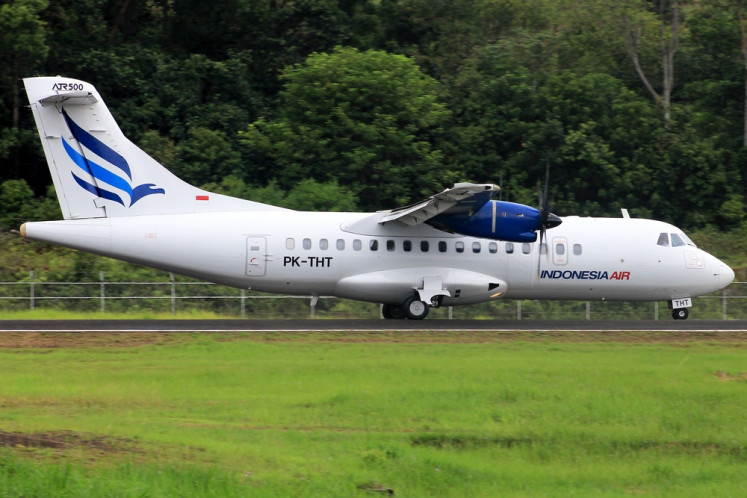Popular Reads
Top Results
Can't find what you're looking for?
View all search resultsPopular Reads
Top Results
Can't find what you're looking for?
View all search resultsTapping potential young voters from the Citayam Fashion Week phenomenon
The rural youths are known to be less diverse than the urban ones, who have so many distinct interests and activism issues they want to bring forward.
Change text size
Gift Premium Articles
to Anyone
P
ublic places in Jakarta’s most strategic areas have recently been filled with a new phenomenon referred to as “Citayam Fashion Week”: underprivileged youths from Jakarta’s outskirts, in this case Citayam near Bogor, West Java, dress up in downtown public places and facilities with their peers.
The disparity between public spaces in their area and the ones in the city center drives them to flock to the latter. They gather in certain spots sporting clothing pieces and accessories that scream fashion statements to express themselves -- hence the term derived from infamous fashion events held regularly in cosmopolitan cities such as New York, Paris and Milan.
Despite the seemingly splendid reference, the term is intended to be pejorative and condescending to disparage the youths’ low socioeconomic backdrop. This is due to the visuals these youths exhibit in their appearance, which may be regarded as plebeian and distasteful -- in contrast to the common aesthetic standard upheld by privileged urban youths.
However, it is important not to overlook the difference in purchasing powers between the two social statures. Citayam youths ought to be thriftier when keeping up with the ever-changing trends albeit with their constrained resources. Finite access to more sophisticated content that would broaden their fashion insights may also play a role in the situation.
On the other hand, many also applaud these youngsters for creatively overcoming their limits. They add new nuances to the oversaturated urban-fashion scenery with eccentric style as covered by the Japanese fashion media (Tokyo Fashion, 2022); furthermore, while asserting their rights to occupy decent public spaces. which are lacking due to improper urban-planning strategies.
Economically speaking, the activity has also been reported to add revenue streams for the street vendors in surrounding areas. Not to mention that it improves the digital content productivity of these Citayam youths as can be seen on social media like TikTok, Instagram and YouTube. Some of them even turned out to attain more of the spotlight than others and use it to advocate their rights in public places and express themselves accordingly.
The last occurrence has in turn created potential opinion leaders and role models among the community of outskirt youths that soon, if not already, will give them the capability to influence their peers’ decisions -- with most of them being of voting age -- while the rest will follow suit by the time the next election cycle is around the corner.
Political parties can capitalize on this by tapping into this young voter pool. There are several remarks about why this would be a strategic measure to get a head start.
First: obviously, this group has almost the same proportion as the urban youths with the ratio of 42.17 percent and 57.83 percent respectively (Indonesian Youth Statistic, 2020). The rural youths are known to be less diverse than the urban ones, who have so many distinct interests and activism issues they want to bring forward. Thus, the former is easier for political parties to approach, with only a few political agendas that fit their needs, such as structural disparities, the widening gap between them and urban youths and uneven distribution of internet access (Nowak, 2021).
Second, even with this almost-balanced scale between the rural and the urban youths, the former has often been overlooked by the political parties and their stakeholders. This is because rural youths are perceived to be less engaged in civic actions and social projects compared to urban ones (Lam-Knott & Cheng, 2020).
This phenomenon of Citayam youths acting autonomously in claiming the public place as theirs, however, breaks the destructive stigma. They do have individual and collective agency, and they are also resourceful as evident in the way they have turned the negative outlook being thrown at them into self-empowerment and embraced their “otherness” identity. Successfully tapping into this pool can strengthen the young-supporter baseline of any coalition.
Lastly, the fact that they have been overlooked indicates that they are an untapped, if not underrepresented, segment. The growing positive exposure and nationwide attention aimed at them make it even more valuable to garner their political endorsement.
With the wonder of digital technology, they will learn how to fully wield their voice and employ it to support whatever causes they want to, including supporting electoral candidates of their choice. Seeing them as they are now, it can be concluded that they tend to be highly expressive and enthusiastic in voicing their aspirations and this kind of energy will generate organic support in return.
Just like any other segment, the best way to infiltrate this group is by identifying the potential opinion leaders and role models borne out of this phenomenon. They are the keys to approaching the outskirt-youth communities like those from Citayam.
While there are many outstanding opinion leaders among the urban youngsters already, the relevance to rural youths is somewhat lacking due to different personal experiences and structural problems they face. Putting them all in one box would result in performative activism by the urban youths to the rural ones -- resulting in counterproductivity. Thus, it is crucial to spot the right party as the gatekeeper to attract this community.
The next step would be initiating collaboration to advocate for them. They are facing scrutiny from hostile sentiments, which resulted in eviction from what supposedly are public places. Being sympathetic toward this occurrence may generate a positive outlook, as evinced by Jakarta Governor Anies Baswedan, who encouraged this group to utilize the public spaces downtown (Tirto. id, 2022).
With Anies widely tipped as a promising presidential candidate in 2024, he has strengthened his political position, which is widely known, by siding with the youths in general.
Another strategic step to be deployed is facilitating formal training for these youths to fortify them in achieving their career aspirations -- most of them being professional digital-content creators, fashion designers or fashion marketers. Providing opportunities and training can amplify to the utmost support from them, showing how rural youths from outskirt areas can also participate in the formal workforce with sufficient resources provided to them.
Youth empowerment is something very appealing to and often celebrated by young voters, especially those who are marginalized.
***
The writer is a research intern at the Center of Strategic and International Studies’ Department of Politics and Social Change.










